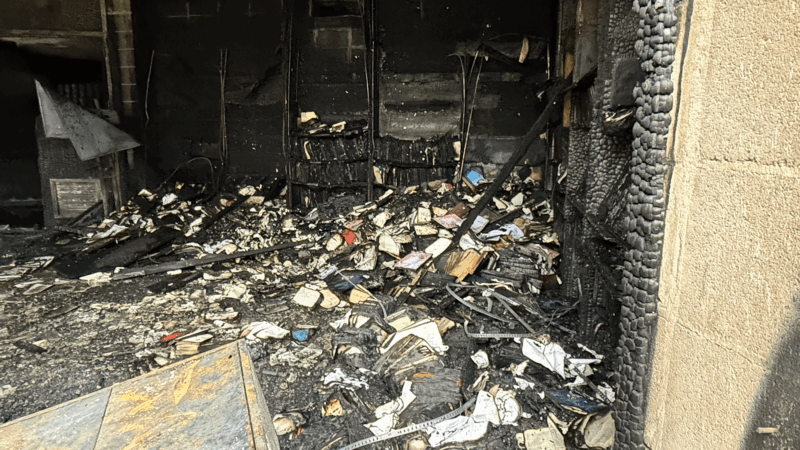Alabama Economy: Homeless
One client stands out, with meticulous makeup, styled hair, and wearing a fashionable black dress with a fur collar. She doesn’t want to give her name (so we’ll call her Margo), but she will share her story. After Margo’s divorce, she moved in with her mother and brother in her parent’s home. Recently, though, her mother had to move to a nursing home, and the family had to sell the house to help pay for her care.
“I lived with my girlfriend awhile and she felt very sorry for me, of course, and she had just gotten an apartment, and I moved in with her. The apartment complex found out I was in there, and had to leave, and it was very sudden.”
For now, Margo calls the First Light shelter “home”. And as the economy worsens, so do a growing number of women. The shelter’s executive director Ruth Crosby says the shelter only has so much space for clients and when it runs out, they’re forced turn some women away.
“It’s very sad. We always try to never turn a woman away with a child. Always get them to where they’re safe, and can get something to eat. But, our overflow shelter is supposed to house about 15, and we have consistently for the past month, had twenty or more in there. So, we have seen a lot and turned away a lot.”
Some of the men and women looking for shelter do have mental health issues and are chronically homeless. But, others find themselves in a situation they would’ve never dreamed of, just a few months ago.
“I was living in Tuscaloosa. I was working.”
When the bad economy hit Jacquelyn Harris, it hit her hard.
“They cut back where I was working and I turned around and lost my apartment and couldn’t pay rent. So, trying to move a 16-year and a baby at the same time, and look for housing. There’s no place in Tuscaloosa I could come, so they told me to try up here.”
Homeless advocates say Harris’ story is typical. Just down the road from First Light, The Old Firehouse Station men’s shelter is also seeing record numbers. Director Steve Freeman says increasingly there’s a new type of client, men from the suburbs, with families.
“We’ve had a man, recently, who came to the shelter, whose house was foreclosed. He lost his job, and I think a couple of months afterward, where he couldn’t afford to pay the house payment, and it was foreclosed on him. And, they ended up on the streets.”
Advocates say many people are teetering on the economic edge. First Light’s Deb Everson says sometimes it doesn’t take much to send them reeling.
“It’s like that house of cards. So, all it takes is one of those cards at the bottom of the stack that’s so important, such as job, car, rent; for those bottom cards in the stack to be removed, the whole stack of cards is going to come crashing down.”
And it’s not just individuals that get pinched. Because of the bad economy, donations to shelter themselves are down while costs are up. At the Old Firehouse Shelter, fuel costs have gone up by half and the overall budget has risen about 25 percent, while donations are down 30 percent from this time last year. Again, director Steve Freeman.
“What that means for a small agency, that is very dependent on non-restricted revenue, is we have to make cutbacks. And, so last year, we made cutbacks of three staff members. In the overall scheme of things, that may not seem like much, but that was about 25 percent of our staff. So, it makes it that much more difficult for us to get individuals off the street.”
And homeless advocates are worried. They say historically, January and February is when their resources are most stretched. But with record numbers of homeless people looking for services right now, that doesn’t bode well for the coming winter months.
Arson engulfs Mississippi synagogue, a congregation once bombed by Ku Klux Klan
A suspect is charged with arson in a fire that burned through a synagogue in Mississippi. Flames and smoke destroyed its library, housing Torahs.
DOJ subpoenas Federal Reserve in escalating pressure campaign
The Justice Department has subpoenaed the Fed over chair Jerome Powell's testimony over the central bank's headquarters renovation. Powell calls it part of a pressure campaign over interest rates.
National Portrait Gallery removes impeachment references next to Trump photo
A new portrait of President Trump is on display at the National Portrait Gallery's "America's Presidents" exhibition. Text accompanying the portrait removes references to Trump's impeachments.
America’s top figure skaters dazzled St. Louis. I left with a new love for the sport.
The U.S. Figure Skating National Championships brought the who's who of the sport to St. Louis. St. Louis Public Radio Visuals Editor Brian Munoz left a new fan of the Olympic sport.
DHS restricts congressional visits to ICE facilities in Minneapolis with new policy
A memo from Homeland Security Secretary Kristi Noem, obtained by NPR, instructs her staff that visits should be requested at least seven days in advance.
Historic upset in English soccer’s FA Cup as Macclesfield beat holders Crystal Palace
The result marks the first time in 117 years that a side from outside the major national leagues has eliminated the reigning FA Cup holders.







